There are over 1700 monasteries in Tibet, and interestingly, most of them are located in the mountains. The world-famous Potala Palace stands tall on a mountain in downtown Lhasa, while near the base of Mt. Everest, you’ll find the world’s highest monastery - Rongbuk Monastery.
So, why are so many Tibetan monasteries built on mountains and what are the top mountain monasteries to visit in Tibet? The answers to these questions are just below. Read on to figure them out and know insider tips for visiting monasteries in Tibet mountains.
Why Are Tibetan Monasteries Built on Mountains?
Tibet’s most monasteries are built on mountains or in remote areas. Why? There are two main reasons.
First, Tibetans believe there are deities residing in the mountains. They also trust that the masters who have reached enlightenment will return to these holy mountains to guide those who are still in their practice.
Therefore, monasteries built on mountains will be blessed by deities and monks studying in the monasteries will be better instructed by predecessors.
Secondly, remote locations make pilgrimages harder. Monasteries in mountains are far away from human settlements, so pilgrims have to travel long distances to get there. Challenges along the way are believed to be tests from the deities.
Join our most popular Lhasa and EBC tour for a smooth experience!
#1 Potala Palace - The UNESCO World Heritage Towering Above Lhasa
Sitting on top of Marpo Ri, the “Red Hill”, Potala Palace rises over 300 meters above the ground floor. The grand palace is a 13-story building, very impressive. It’s the prior important mountain monastery in Tibet, both materially and spiritually.
When walking into the Potala Palace, you are likely to visit a giant museum. Hundreds and thousands of murals and painted scrolls are whispering the stories of the successive Dalai Lamas. Tons of fine sculptures, porcelain, jade, gold and silver, as well as a large collection of Buddhist sutras are waiting to explore.
Tibetans believe completing the climbing of the steep cliffs is a practice to overcome the desires. However, the climb is not easy and may take longer than you expect, due to the high altitude. It’s best to wear comfortable shoes and avoid visiting Potala Palace immediately upon your arrival in Lhasa.
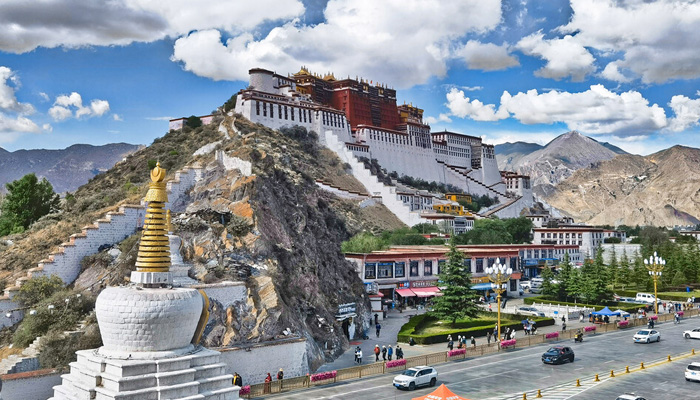 Potala Palace sits high above Lhasa city.
Potala Palace sits high above Lhasa city.#2 Drepung Monastery - The Largest Monastery in Tibet
Drepung is the largest of all Tibetan mountain monasteries, located on the Gambo Utse mountain, which is about 5 kilometers west of Lhasa. It once housed over ten thousand monks at a time, being one of the largest monasteries in the world. Today, it serves as an influential Buddhist college for monks to study classic Tibetan Buddhism.
Here, you can explore the Coqen Hall, to learn the worldview of Tibetan Buddhism, and the stories of some famous figures in Tibetan Buddhist history. You can also learn how monks practice and study when touring the Loseling College.
As the main place of the Shoton Festival ceremony, Drepung Monastery attracts crowds of pilgrims and tourists to come every year. During the festival, a thangka over 100 meters high will be unveiled on a giant frame on the side of the hill behind the monastery. It’s a great chance for you to experience the Tibetan Buddhism culture.
 Drepung Monastery is the largest Monastery in Tibet.
Drepung Monastery is the largest Monastery in Tibet.#3 Ganden Monastery - Overlooking the Lhasa River Valley
Ganden Monastery, together with Drepung and Sera, are the “great three” Gelug university monasteries of Tibet. Ganden Monastery seats at the top of Wangbur Mountain, around 40 kilometers northeast of Lhasa.
A trek around the monastery offers dramatic views over the valleys that surround it. You can also do the scenic trek from Ganden to Samye Monastery, one of Tibet’s most popular treks. Covering a distance of 80 kilometers, the trek takes about 4 to 5 days to complete and offers breathtaking views en route.
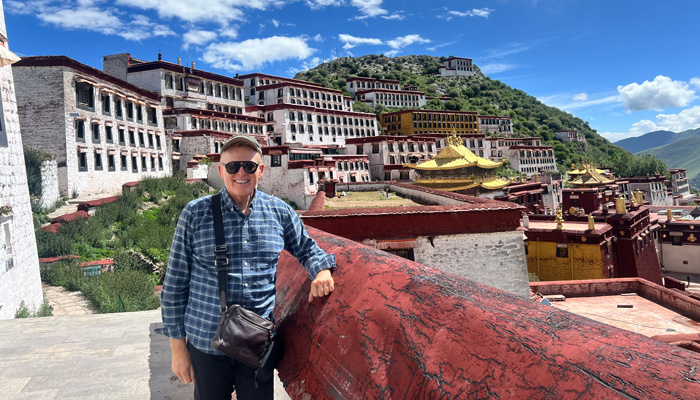 Our guest paid a visit to the Ganden Monastery.
Our guest paid a visit to the Ganden Monastery.#4 Rongbuk Monastery - The World’s Highest Monastery Near Mount Everest
Lying at an altitude of 4,980 meters, Rongbuk Monastery is the highest monastery in the world. Close to the Everest Base Camp, the monastery is one of the best places to view Mount Everest.
Founded by Nyingma sect of Tibetan Buddhism, Rongbuk Monastery is unique as it houses both monks and nuns together. It is accessible by road after a couple of hours’ drive from the Friendship Highway. To visit the monastery and Mount Everest, you can join our classic tour from Lhasa to Everest Base Camp.
For trekker lovers, you can also trek to Tibet EBC from old Tingri, much more thrilling than taking the tourist buses. Along the way, you will pass through beautiful Tibetan villages and breathtaking valleys before reaching Rongbuk Monastery and Everest Base Camp.
 Taking a photo of Mount Everest at Rongbuk Monastery
Taking a photo of Mount Everest at Rongbuk MonasteryJoin our most popular Lhasa and EBC tour for a smooth experience!
#5 Drak Yerpa - A Quiet Retreat with Ancient Meditation Caves
Drak Yerpa is a quiet meditation place located about 30 kilometers from Lhasa. It sits atop a steep mountain, and boasts some ancient meditation caves, which have been used by generations of saints in Tibetan history, including Master Tsongkhapa and Tibetan King Srongtsen Gampo.
If you want to enjoy a peaceful spiritual moment during the Tibet tour, you can come to visit the Drak Yerpa after your Lhasa city sightseeing. Find your favorite medication cave, sit cross-legged, and feel the precious tranquility. You can also combine it with a visit to the Ganden Monastery.
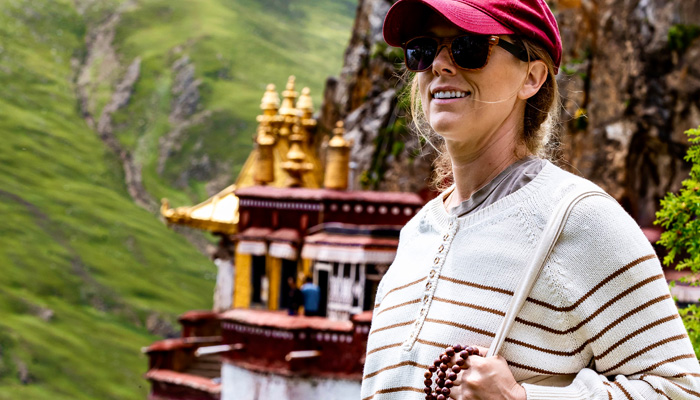 Drak Yerpa Monastery sits atop a steep mountain.
Drak Yerpa Monastery sits atop a steep mountain.#6 Drigung Til Monastery - The Holy Sky Burial Site in the Lhasa Region
About 120 kilometers northeast of Lhasa, Drigung Til Monastery wind its way along the south slope of a long mountain ridge. From the main courtyard of the monastery, you have a 180-degree views of the serene valley.
Drigung Til Monastery is the holiest sky burial site in Lhasa region. Tibetans travel hundreds of kilometers to bring their deceased relatives here. Although tourists are forbidden to watch the sky burials, you can hike up the site when no ceremonies are taking place.
 Drigung Til Monastery is the holiest sky burial site in Lhasa region.
Drigung Til Monastery is the holiest sky burial site in Lhasa region.How to Visit These Mountain Monasteries: Permits, Tips and More
1. Prepare Tibet Travel Permits
Before you start your journey, you will first need the Tibet Travel Permit for your Tibet tour. For visiting remote areas like the Everest region, additional permits are also required. We will take care of all the necessary Tibet travel documents as long as you book your Tibet tour with us.
2. Travel with a Local Guide
International tourists must join a guided tour in Tibet. This actually helps a lot - especially when you visit Tibetan monasteries and other cultural sites. All our tour packages provide experienced local Tibetan guides, and they will explain details of Tibetan culture and religion for you, as well as ensure you a smooth and hassle-free trip.
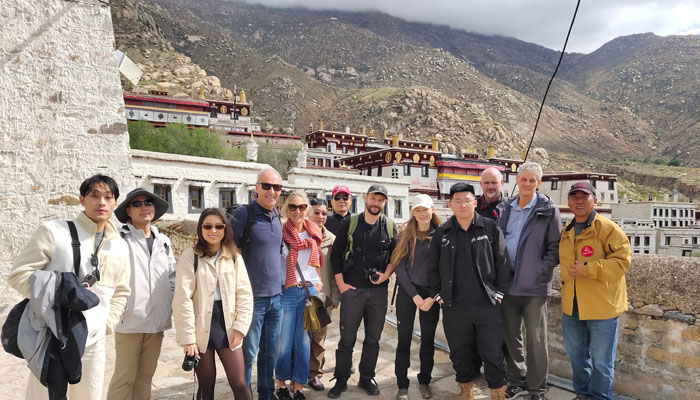 Visiting Drepung Monastery with our Tibetan travel guide
Visiting Drepung Monastery with our Tibetan travel guide3. Dress Modestly and Respect Customs
Don't expose your body too much - Exposing your body too much is a disrespect to the deities. Avoid wearing too skimpy clothes such as mini skirts and shorts that are above the knees.
Do remove hat, sunglasses, and keep silent - When you enter the rooms of Tibetan monasteries, please remove your hats and sunglasses to show your respects to deities. And switch your mobile phone to silent mode.
Don’t photograph inside the Buddhist halls or rooms - Basically, photography is forbidden inside the Buddhist halls or rooms. Don't aim your camera at the statue of Buddha enshrined inside the monastery, which is totally unacceptable.
4. Pay Attention to the Altitude Sickness
Since most Tibetan monasteries are located at high elevations, it is important to acclimatize properly before visiting them. Especially if you are going to visit Rongbuk Monastery and Everest Base Camp, you’d better spend several days in Lhasa first and then travel overland for a gradual ascent.
Join our most popular Lhasa and EBC tour for a smooth experience!
Conclusion
Visiting Tibetan monastery is an important part of your Tibet tour. From remote Rongbuk Monastery in the Everest region to Ganden Monastery near Lhasa, you can choose from a collection of top monasteries in Tibetan mountains. During your visit to these monasteries, you can also appreciate stunning nature views, do trekking, and more.
As the leading Tibet tour operator, we are here to help you enjoy a smooth visit to Tibetan mountain monasteries. We handle every detail for your Tibet trip, including local guides, experienced drivers, Tibet travel documents, accommodations, etc. Just contact us now and join us for a wonderful trip to Tibet!





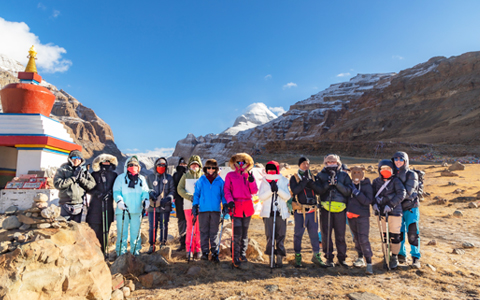

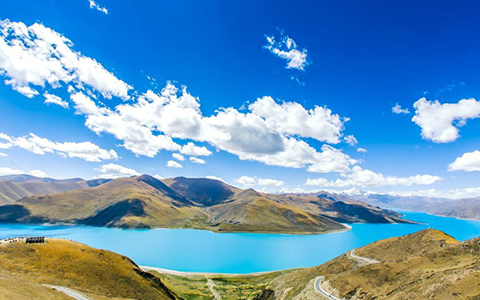
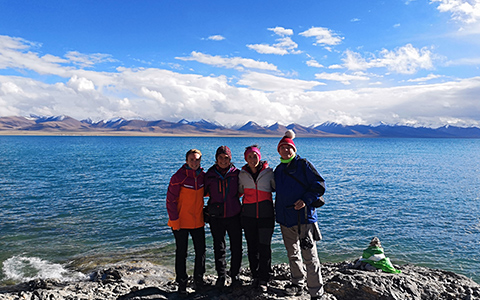
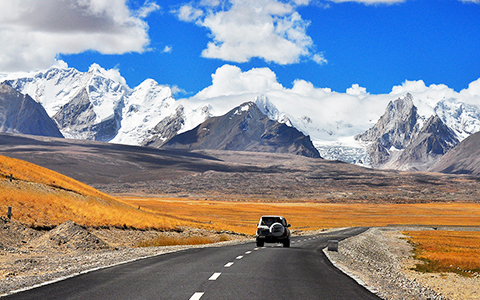
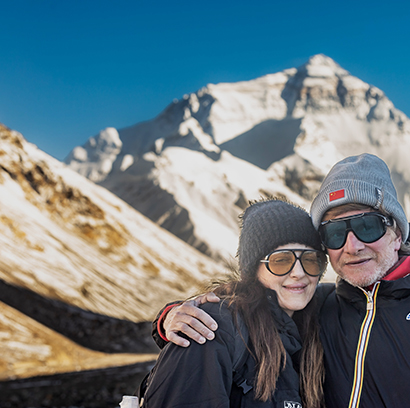

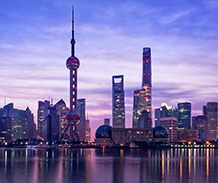
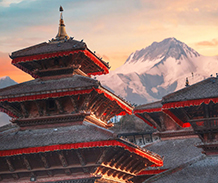
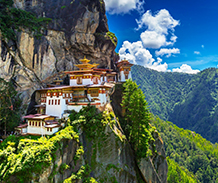
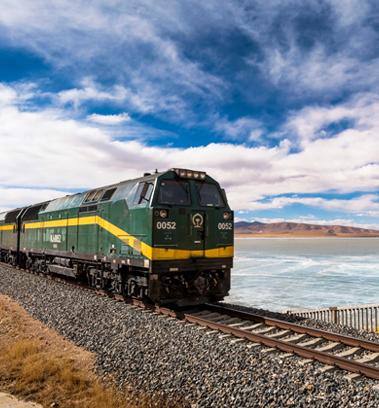



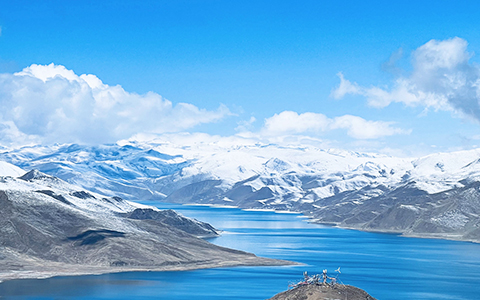
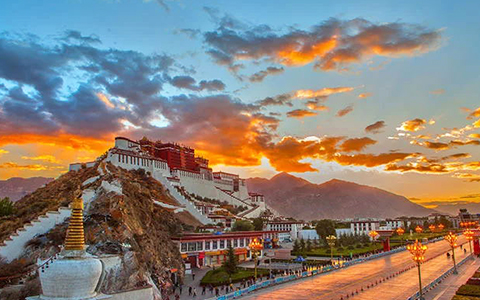






 Potala Palace sits high above Lhasa city.
Potala Palace sits high above Lhasa city. Drepung Monastery is the largest Monastery in Tibet.
Drepung Monastery is the largest Monastery in Tibet. Our guest paid a visit to the Ganden Monastery.
Our guest paid a visit to the Ganden Monastery. Taking a photo of Mount Everest at Rongbuk Monastery
Taking a photo of Mount Everest at Rongbuk Monastery Drak Yerpa Monastery sits atop a steep mountain.
Drak Yerpa Monastery sits atop a steep mountain. Drigung Til Monastery is the holiest sky burial site in Lhasa region.
Drigung Til Monastery is the holiest sky burial site in Lhasa region. Visiting Drepung Monastery with our Tibetan travel guide
Visiting Drepung Monastery with our Tibetan travel guide
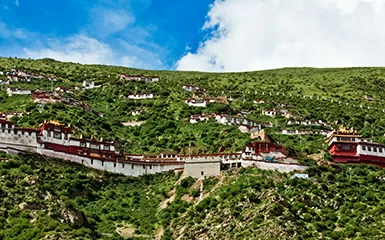
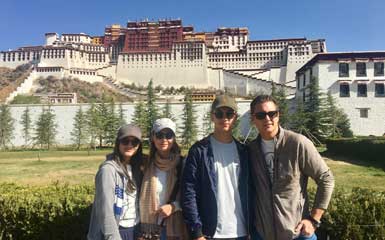

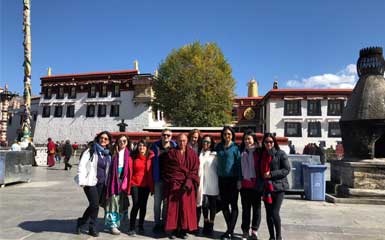
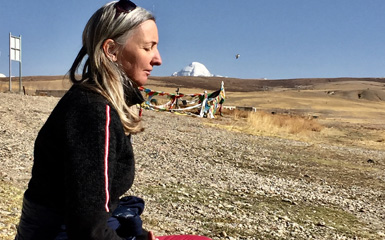


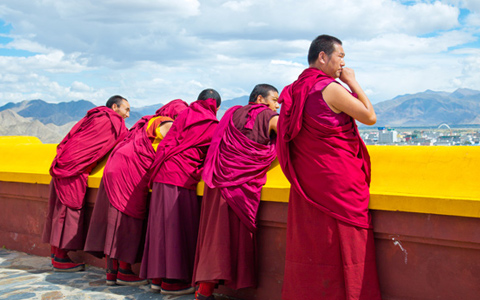
Ask a Quick Question